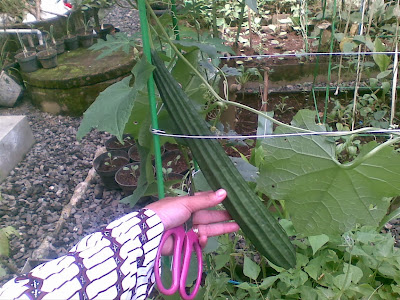The fruit is usually harvested in the medium stage of maturity.
Not too young or too old.
On the medium stage of maturity the size it big enough, but the texture is still tender.
The mature fruit will be rich of coarse fiber.
The texture will be so coarse and fibrous, and the taste is a little bit bitter.
The size of the fruit is depend on the variety and maturity.
It's about 30-60 cm on length, and the diameter is about 5 cm.
The fruit is usually ready to be picked 8 -10 days after pollination, even more.
To get the long and straight fruit, traditional farmer usually give a little load on the end of the fruit using a rope.
The load is usually a little stone that wrapped in plastic bag and the bag is tied using a rope.
The gravitation effect is really work, make the fruit is so long and straight.
But I'm just a lazy gardener, I let the fruit grows naturally.
So the shape is so various.
Long, short, medium, straight, curve, curvaceous and many more...
Whatever, the straight fruit makes us easier to clean when it prepared to be cooked.
Next we will talk about the plant maintenance.





Interesting how they achieve straight fruits but I'm like you and not worried about the shape.
ReplyDeleteYes, more natural is much better.
DeleteVery interesting post...Look forward to more. Have a warm day!
ReplyDeleteThank you, Teresa. Keep warm and healthy.
DeleteWould this technique work with Oriental Cucumbers?
ReplyDeleteI'm not sure about that. This technique is also used with bitter gourd here.
DeleteWow, tying weights to the fruits to shape them - that is a lot of effort for pretty gourds!
ReplyDeleteYes. Different way on different place. So nice to know about the differences.
DeleteI've never tasted this fruit, although I think we can get them in our grocery markets--probably grown in Florida or California and flown in. I would be like you--happy with whatever shape the fruit would take.
ReplyDeleteMaybe you could taste it and get the benefit.
DeleteI love how the fruit is "flutted".
ReplyDeleteYes, me too...:)
Delete